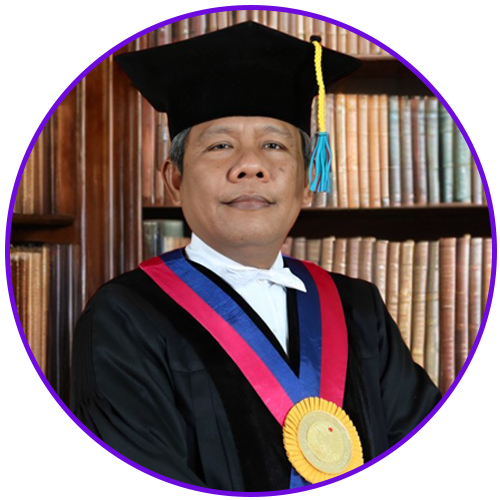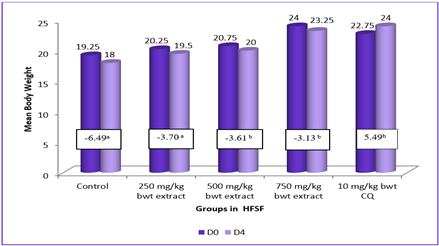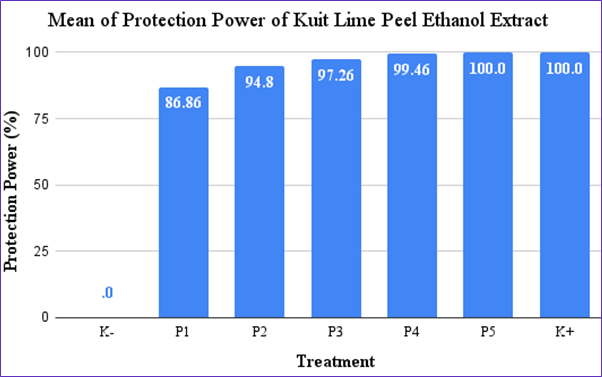Repellent Effectiveness of Permot Leaf Ethanol Extract (Passiflora Foetida Linn.) against Aedes Aegypti Adult Mosquitoes
Downloads
Indonesia is one of the largest tropical countries in the world and various diseases can arise in the tropics which are caused by animals as vectors. An example of a vector that can carry diseases is a mosquito. Mosquitoes are insects that live side by side with humans buy act as vectors of disease. Mosquito Aedes aegypti is a type of mosquito that can carry the virus that causes Dengue Hemorrhagic Fever. This research was conducted to determine the effectiveness of Permot leaf ethanol extract (Passiflora foetida L.) as an alternative repellent against adult mosquitoes Aedes aegypti. This research was conducted from October to December 2020 and used Permot leaf ethanol extract consisting of 3 cream concentrations, namely 2.5%, 5%, 7.5%, negative control using cream without permot leaf ethanol extract and positive control using mosquito cream. The data of this study were tested using one way ANOVA to find the effectiveness rate and comparations of the each Permot leaf repellent extract. This study proven that the permot leaf ethanol extract is effective as a repellent for Aedes aegypti mosquitoes.
Aini, R., R. Widyastuti dan N.A. Nadhifa. 2016. Uji Efektifitas Formula Spray dari Minyak Atsiri Herba Kemangi (Ocium sanctum. L) sebagai Repellent Nyamuk Aedes aegypti. J. Ilmiah Manuntung. 2(2):189-197.
Basundari, S. A., Tarwotjo, U., dan E. Kusdiyantini. 2018. Pengaruh Kandungan Ekstrak Daun Zodia (Evodia suaveolens) terhadap Mortalitas Larva Nyamuk Aedes aegypti. Bioma. 20(1): 51-58.
Departemen Kesehatan RI. 2000. Modul Epidemiologi Malaria. Ditjen P2M dan PLP. Jakarta. Hal 37.
Djatmiko M, Y. Anas, dan S.M. Handayani. 2011. Uji aktivitas repellent fraksi n-heksan ekstrak etanolik daun mimba (Azadirachta indicaa juss) terhadap nyamuk Aedes aegypti. E-Publikasi Fakultas Farmasi. 3(1):24-30.
Faiq, M. 2015. Efektifitas repelen ekstrak daun Permot (Passiflora foetida L.) terhadap nyamuk culex fatigans dewasa [Skripsi]. Fakultas Kedokteran Hewan. Universitas Airlangga.
Fradin, M.S., and D.F. Day. 2002, Comparative Efficacy of Insect Repellents against Mosquito Bites, The New England Journal of Medicine, Chapel Hill Dermatology, 3(4): 13-18.
Hastutiek P., dan A. Sunarso. 2013. Identifikasi Komponen Kimia Ekstrak daun Permot (Passiflora foetida Linn.) dengan TLC dan GC-MS sebagai Kandidat Bioinsektisida terhadap Nyamuk. Seminar Nasional Biologi/IPA dan Pembelajarannya di Universitas Negeri Malang 1-2 Nop 2014.
Hastutiek, P., dan A. Sunarso. 2015. Gambaran Histopatologi Saluran Pencernaan Larva Instrar IV Nyamuk Aedes aegypti setelah Perendaman dengan Senyawa Aktif Ekstrak Daun Permot (Passiflora foetida Linn.) dan Potensinya sebagai Bioinsektisida. Veterinaria Medika. 8(2): 137-144.
Hastutiek, P., Sunarso, A., and R.H. Prasetyo. 2017. Permot (Passiflora Foetida Linn.) Leaf Extracts as Bioinsecticide Against Aedes aegypti Larvae. The Southest Asian Journal of Tropical Medicine and Public Health. 48(6): 1169-1174.
Herawati, R. 2010. Ekstrak Daun Sirih (Piper betle L.) sebagai Insektisida Nabati untuk Membasmi Larva Nyamuk Aedes aegypti L. [Skripsi]. Fakultas Teknobiologi. Universitas Atma Jaya Yogyakarta. Yogyakarta.
Hidayah, N., Mustafa, H., Murni, dan I. Tolistiawaty. 2018. Efektivitas Repelen Losion Minyak Atsiri Kulit Jeruk Bali (Citrus maxima (Burm.) Merr.) terhadap Aedes aegypti. Balaba. 14(2):159-168.
Ishartadiati, K. 2010. Aedes aegypti sebagai Vektor Demam Berdarah Dengue. Universitas Wijaya Kusuma Surabaya. Surabaya. Hal 31.
Mena, P., Cirlini, M., Tassotti, M., A. Herrlinger, K., Dall' Asta, C., and D. Del Rio. 2016. Phytochemical Profiling of Flavonoids, Phenolic Acids, Terpenoids, and Volatile Fraction of a Rosemary (Rosmarinus officinalis L.) Extract. PubMed. 21(11): 1-15.
Millati, F. F., Ferry, dan F. Sofian. 2018. Review Artikel: Kandungan Senyawa Minyak Atsiri pada Tanaman Pengusir Nyamuk. Jurnal Farmaka. 16(2):572-580.
Murrukmihadi, M and D.A. Fajarini. 2015. Repelen Activity Test of Essential Oil of Basil Leaves (Ocimum basilicum L.) (f. Citratum Back) against Aedes aegypti Lotion and Physical Characteristics Test of The Lotion. Traditional Medicine J. 20(2): 91-97.
Padmasari, P.D., K.W. Astuti, dan N.K. Warditiani. 2013. Skrining Fitokimia Ekstrak Etanol 70% Rimpang Bangle (Zingiber purpureum Roxb.). Fakultas Matematika dan Ilmu Pengetahuan Alam. Universitas Udayana. Denpasar. Hal 20.
Rahayu, S. P., dan S. Naimah. 2010. Pembuatan formulasi krim anti nyamuk dari fraksi minyak sereh. Jurnal Kimia dan Kemasan, 32(2): 53-61.
Rizki, D. A., Budiyono, dan R. Hestiningsih. 2015. Daya Tolak Repellent Bentuk Lotion dengan Ekstrak Daun Alpukat (Persea americana Mill) Terhadap Nyamuk Aedes aegypti Linn. Jurnal Kesehatan Masyarakat. 3(3): 702-711.
Romandoni, F. N. 2019. Hubungan Upaya Pencegahan terhadap Kejadian Penyakit DBD pada Masyarakat di Desa Gemaharjo Wilayah Kerja Puskesmas Gemaharjo Kabupaten Pacitan. [Skripsi] Stikes Bhakti Husada Mulia Madiun.
Sanjaya Y., Adisenjaya, Yusuf H., dan L. Wijayanti. 2014. Efektivitas Daya Tolak Ekstrak Geranium radula C. Terhadap Nyamuk Aedes aegypti (Linn.). Bionatura. 16(2): 62-67.
Susilowati, R.P. 2016. Uji Toksisitas Obat Nyamuk Bakar Herbal Berbahan Ekstrak Daun Permot (Passiflora foetida): Kajian Histopatologis Hati dan Ginjal Mencit. Prosiding SNPBS (Seminar Nasional Pendidikan Biologi dan Saintek) Ke-1 hal 492-497.
Suwasono, H., dan Ch. P, B. 2009. Uji Efikasi Repelen "X" terhadap Nyamuk Aedes aegypti, Culex quinquefasciatus dan Anopheles aconitus di Laboratorium. Jurnal Vektor 1(2): 101-108.
Taslimah. 2014. Uji Efikasi Ekstrak Biji Srikaya (Annona squamosal L.) sebagai Bioinsektisida dalam Upaya Integrated Vector Management terhadap Aedes aegypti [Skripsi]. Fakultas Kedokteran dan Ilmu Kesehatan. UIN Syarief Hidayatullah Jakarta.
Werdiningsih, I., dan R. Amelia. 2018. Lotion Ekstrak Daun Ekstrak Daun Zodia (Evodia sauveolens) sebagai Repellent Nyamuk Aedes sp. Jurnal Sains dan Seni. 1(1): 1-4.
Copyright (c) 2021 Journal of Parasite Science

This work is licensed under a Creative Commons Attribution-NonCommercial-ShareAlike 4.0 International License.
- Every manuscript submitted to must observe the policy and terms set by the Journal of Parasite Science
- Publication rights to manuscript content published by the Journal of Parasite Science is owned by the Journal of Parasite Science with the consent and approval of the author(s) concerned
- Authors and other parties are bound to the Creative Commons Attribution-NonCommercial-ShareAlike 4.0 International License for the published articles, legal formal aspect of journal publication accessibility refers to Creative Commons Attribution-NonCommercial-ShareAlike 4.0 International License (CC BY-NC-SA)
- By submitting the manuscript, the author agrees to the requirement that the copyright of the submitted article will be transferred to Journal of Parasite Science as the publisher of the journal. The intended copyright includes the right to publish articles in various forms (including reprints). journal of parasite science retains the publishing rights to published articles.

































